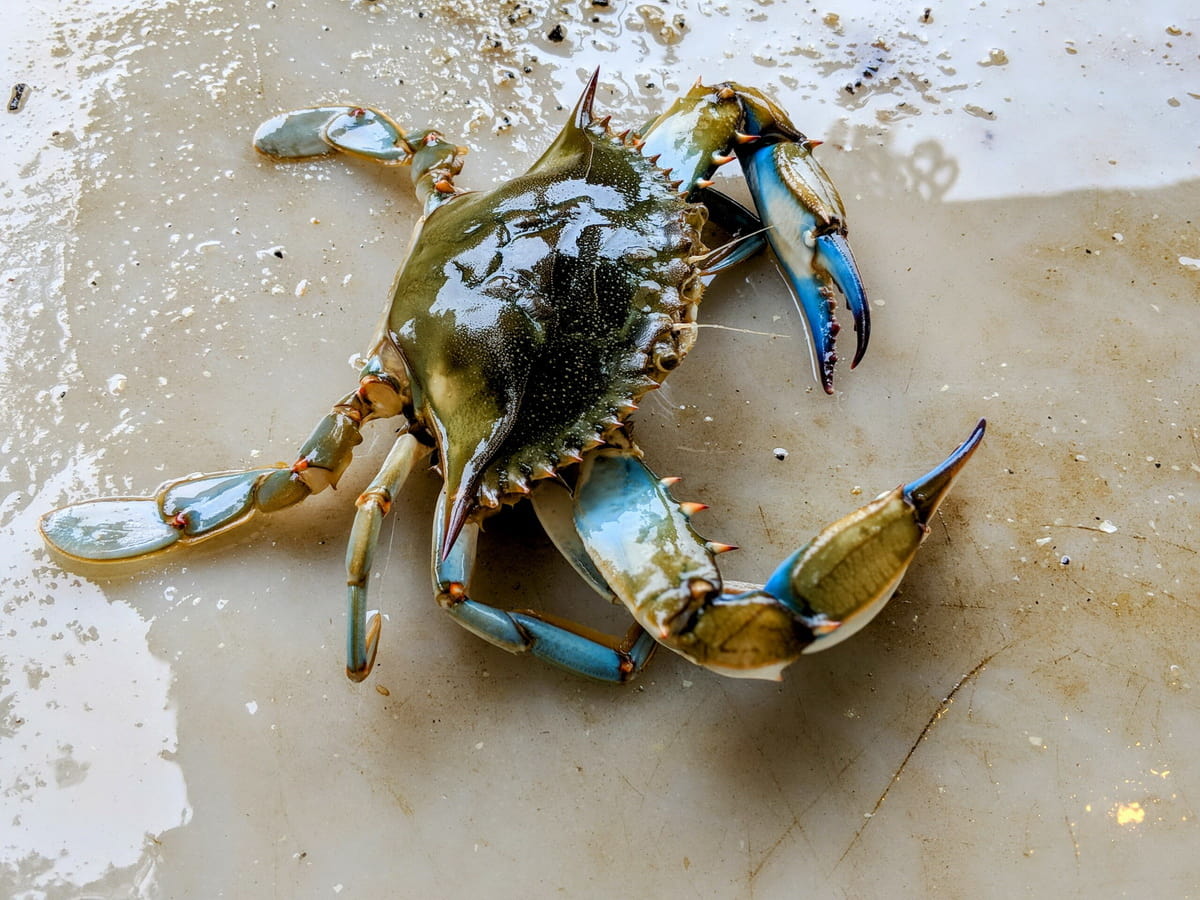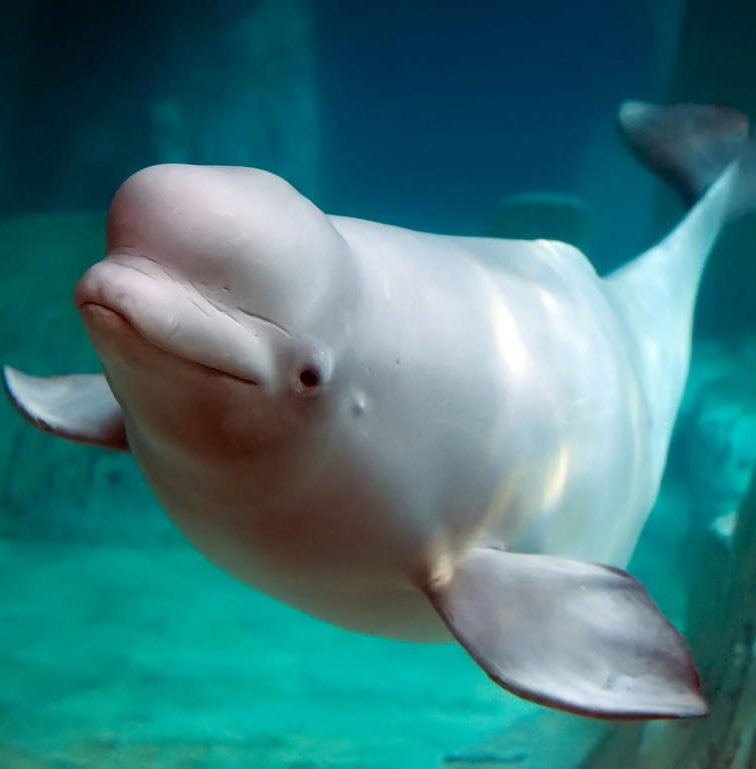Renowned for their striking blue hue, blue crabs (Callinectes sapidus) are not just culinary delights but also key players in marine ecosystems. Inhabiting the Atlantic Ocean and the Gulf of Mexico, these crabs exhibit fascinating behaviors and life cycles.
From their unique coloration and regeneration abilities to their crucial ecological roles, blue crabs are a symbol of the intricate web of life beneath the waves. Exploring fun facts about blue crabs offers us a glimpse into their intriguing underwater world.
1. Blue Crabs’ Unique Coloration: More Than Just Blue
The unique coloration of blue crabs is indeed more than just blue. They are known for their bright blue claws, especially in males, and olive-colored carapace. The females, however, are distinguished by their red-tipped claws.
This coloration is not only striking but also serves important biological functions, such as species recognition and mating displays. The vibrant blue in males and the red tips in females are key characteristics that set them apart in the aquatic environment they inhabit.
2. Blue Crabs’ Lifespan: How Long They Live
Blue crabs typically live for 3 to 4 years, reaching maturity within 12 to 18 months. Growth rates are influenced by water temperature, with crabs in warmer waters like the Gulf of Mexico maturing faster than those in cooler waters such as the Chesapeake Bay.
These crustaceans undergo multiple molts as they grow, but females molt just once before they are ready to mate. The lifespan of blue crabs can vary based on environmental factors, but they are generally harvested before reaching their maximum size.
3. Blue Crabs’ Egg Carrying: A Remarkable Reproductive Process
Female blue crabs, known for their remarkable egg-carrying capacity, undergo a fascinating reproductive process. After mating, which usually occurs between May and October, a female carries up to two million eggs in a spongy mass. This mass starts off orange in color, darkening as the hatching time nears.
These eggs undergo several developmental stages to reach adulthood, showcasing the blue crab’s complex life cycle. The egg-carrying phase is a critical period, highlighting the female crab’s vital role in sustaining the species’ population.
This process is a cornerstone of the blue crab’s life history, emphasizing the species’ reproductive efficiency and ecological importance.
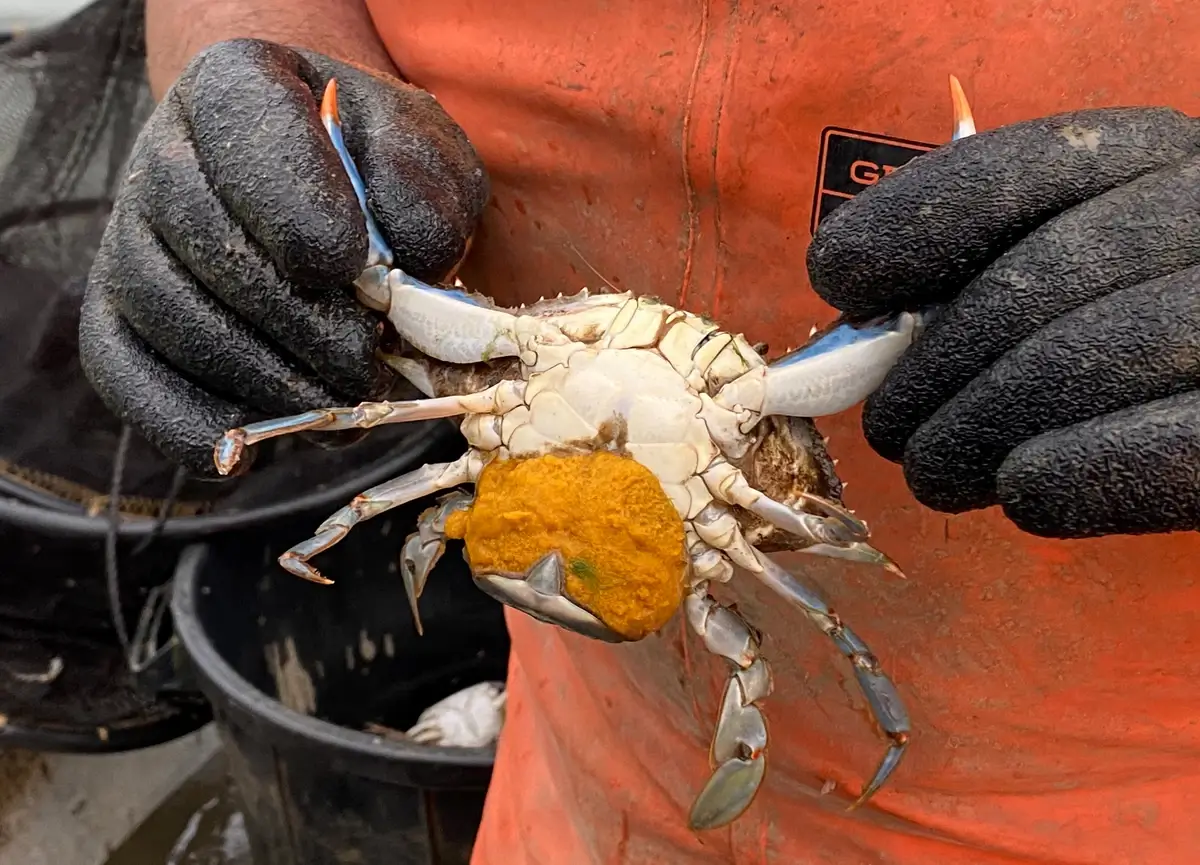
Image: reuters.com
4. Blue Crabs’ Molting Process: Key to Growth and Survival
The blue crab’s molting process is vital for its growth and development. Like all crustaceans, blue crabs shed their hard exoskeleton as they grow, a process known as molting.
During molting, the crab forms a new, larger exoskeleton underneath the old one. Once the new shell is ready, the crab sheds the old shell, leaving itself vulnerable until the new shell hardens. This phase is critical as it allows the crab to increase in size.
Soft-shell crabs, a popular culinary delicacy, are blue crabs that have recently molted and are still soft. This stage makes them vulnerable to predators, including humans who harvest them for their delicate flavor.
5. Blue Crab’s Diet: A Diverse Underwater Buffet
Blue crabs are omnivorous scavengers, feeding on a wide array of food sources. Their diet primarily includes clams, oysters, insects, mussels, worms, recently dead fish, and sometimes, other crabs. This diverse diet is essential for their growth and survival.
Their feeding habits also play a significant role in maintaining the ecological balance of their habitats. As both predators and scavengers, blue crabs contribute to controlling the populations of various marine organisms and cleaning up the aquatic environment.
Their ability to consume a wide range of food items reflects their adaptability to different environmental conditions.
6. Blue Crabs’ Speed and Agility: Masters of Quick Escape
Blue crabs are known for their remarkable speed and agility in the water, primarily attributed to their unique physical adaptations. Their rear pair of legs, shaped like paddles, are specialized for swimming, enabling these crabs to move quickly and with agility in their aquatic environments. This adaptation is particularly useful for escaping predators and catching prey, making them skilled hunters and survivors.
Blue crabs’ ability to swiftly navigate through the water is a key aspect of their survival strategy, allowing them to thrive in various marine habitats, including estuaries and coastal lagoons.
7. The Economic Importance of Blue Crabs: A Crustacean Goldmine
Blue crab fishing and harvesting have long been integral to Maryland’s economy and cultural heritage, particularly in the Chesapeake Bay region. This crustacean has not only been a staple food source for generations but also a significant contributor to the local fishing industry.
The complex nature of the blue crab’s life history, including its varied habitat use and migration patterns, adds to the challenges of sustainable fisheries management. Various strategies, such as a state program to buy unused commercial fishing licenses, have been implemented to control fishing pressure and maintain market stability.
These efforts aim to conserve the crab population while supporting the livelihoods of Chesapeake watermen and crab processors. The blue crab industry’s value extends beyond its economic impact, reflecting its deep-rooted significance in the region’s culture and way of life.
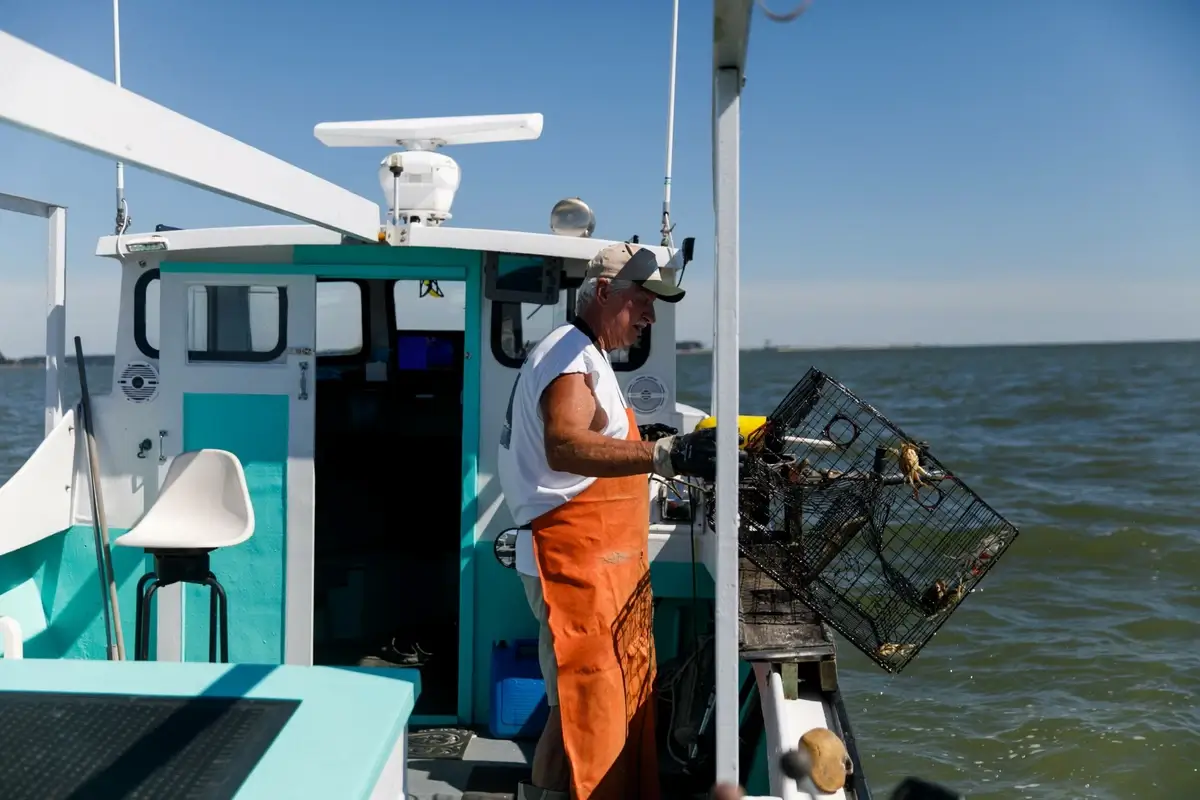
Image: insideclimatenews.org
8. Blue Crabs’ Navigation Skills: A Built-in Compass
While detailed scientific studies specifically focusing on their navigation skills are limited, their life history gives insights into their adept movement. Blue crabs migrate for foraging, mating, molting, and completing the female spawning migration. The complexity of these movements, particularly the female spawning migration to specific estuarine regions, suggests an inherent navigational skill set.
Blue crabs utilize a range of habitats throughout their life cycle, indicating an ability to navigate through differing environmental conditions effectively.
9. Blue Crabs’ Mating Rituals: A Dance of Courtship
In the intricate courtship of blue crabs, the female releases pheromones, signaling her readiness to mate. She seeks a large male, capable of providing abundant sperm. The male, in response, performs a pre-mating dance, displaying his size and strength by standing tall and spreading his claws.
This ritual is crucial, as the female molts only once for mating. The male’s abrupt yet gentle grab, often resembling an attack, ensures he protects her during her vulnerable molting period. Post-mating, he guards her until her new shell hardens.
This unique mating behavior underscores the complex reproductive strategies of blue crabs.
10. Blue Crabs and Climate Change: A Vulnerable Species
Blue crabs are facing significant challenges due to climate change. Research indicates that larval blue crabs experience increased mortality under conditions of low oxygen and/or low pH, common in their estuarine habitats.
These issues are exacerbated by climate change, which is decreasing oxygen and pH levels in oceans. The combination of these factors poses a dire threat to the survival of blue crab larvae, potentially impacting their overall populations in regions like the Chesapeake Bay.
Climate change is not just altering the water quality but also affecting the entire ecosystem, which could further challenge the survival of blue crabs.
11. Blue Crab’s Predators: A Tough Life in the Food Chain
Blue crabs are a crucial part of marine ecosystems and have several natural predators. These predators include large fish like red drum and Atlantic croaker, birds such as herons, sea turtles, and humans, who are perhaps their most significant predator due to commercial and recreational fishing.
The blue crab’s lifecycle and behavior make it vulnerable to these predators at various stages. For instance, juvenile blue crabs are particularly susceptible to predation. This predator-prey dynamic is essential for maintaining the ecological balance in habitats where blue crabs are found, such as the Chesapeake Bay and Gulf of Mexico.
The blue crab’s role as both predator and prey reflects its significance in the food web and highlights the importance of sustainable fishing practices to ensure the health and balance of marine ecosystems.
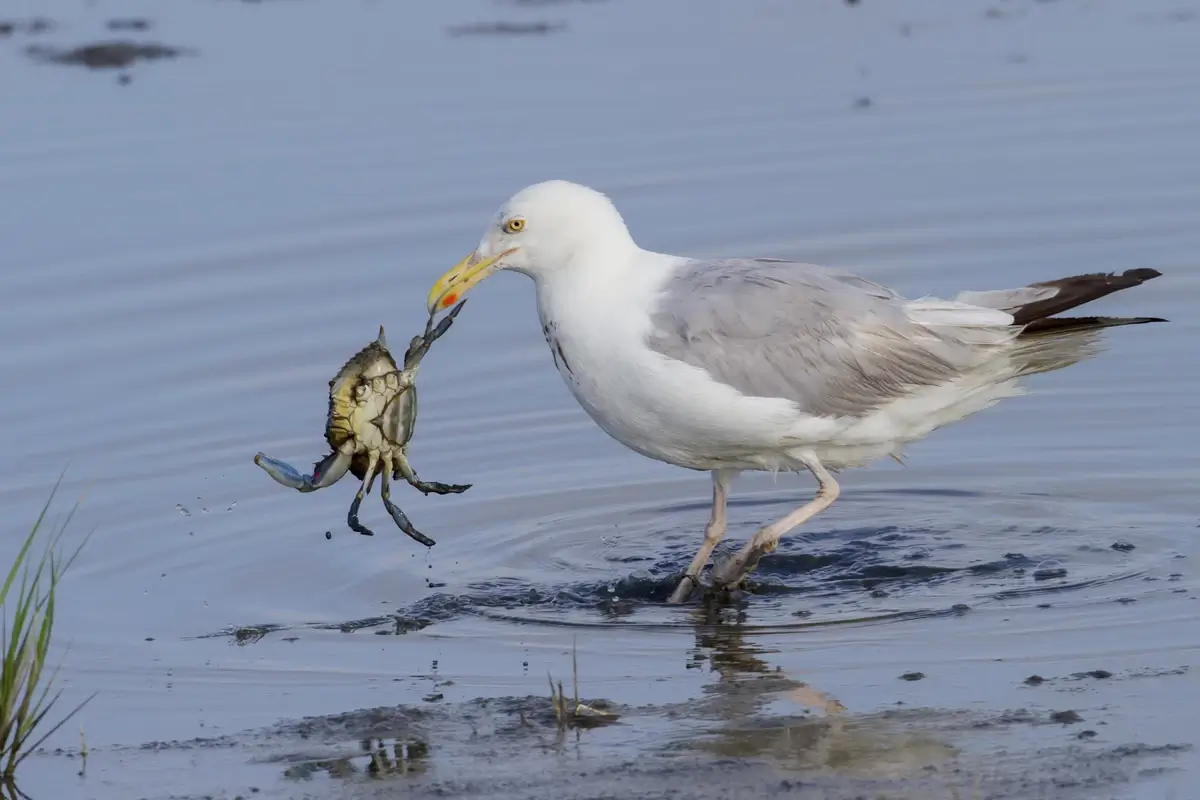
Image: imgur.com
12. Blue Crabs’ Sensory Organs: Seeing and Feeling Underwater
Blue crabs are equipped with sophisticated sensory organs, crucial for survival and effective feeding. They have chemoreceptors on their antennules, mouthparts, and pereiopods, which detect chemical stimuli for locating food and identifying threats.
An intriguing feature is the presence of chemoreceptors in the oesophagus, sensitive to deterrent compounds in food. This system guides the crabs in rejecting or manipulating unpalatable food, a critical survival mechanism.
This biting behavior, allowing deterrents to reach the oesophageal receptors, is essential for food rejection. The proximity-based action of these chemoreceptors emphasizes their role in predator-prey interactions and ecological dynamics.
13. Blue Crabs’ Habitat: From Freshwater to Salty Seas
Blue crabs thrive in a range of aquatic environments, showcasing their remarkable adaptability. Native to the Atlantic Coast of the Americas, from Nova Scotia to Argentina, including the Gulf of Mexico, blue crabs are commonly found in habitats like salt marshes, estuaries, and bays.
They prefer shallow waters, typically less than 30 feet deep, often in areas with sandy or muddy bottoms. In the Chesapeake Bay, males usually favor the fresher waters of upper tributaries, while females are drawn to saltier waters near the ocean.
This ability to inhabit diverse water conditions, from brackish to fully saline, is a testament to the blue crab’s versatility. Their presence in multiple habitats throughout their life, including underwater grasses and oyster reefs, underscores their importance in various marine ecosystems. The crabs’ habitat preferences also influence their growth, reproduction, and survival, making them an integral part of the ecological balance in these areas.
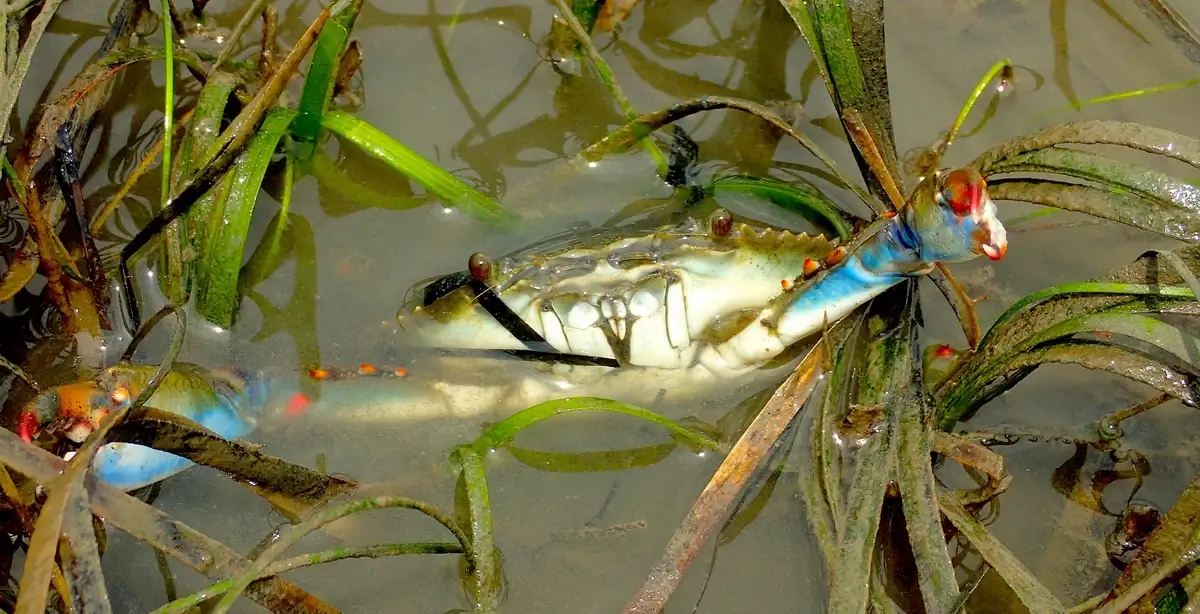
Image: ncseagrant.ncsu.edu
14. Blue Crabs in Culinary Arts: A Delicacy Worldwide
In the culinary world, blue crabs are celebrated for their delicious meat, making them a sought-after delicacy in many coastal regions. Their succulent and flavorful meat is a staple in various cuisines, especially in regions like the Chesapeake Bay.
Dishes like crab cakes and crab boils are not only culinary delights but also form a part of the cultural heritage of these regions. The economic importance of blue crabs in the seafood industry is substantial, with their harvest supporting local economies and providing employment opportunities in fishing communities.
15. Blue Crabs’ Regeneration: The Power of Claw Re-Growth
Blue crabs possess an extraordinary ability to regenerate lost limbs, including their claws. When a crab loses a claw, a small bud-like structure forms on the stump, consisting of undifferentiated cells. These cells differentiate into various types needed to form a new claw.
The process can take several months to a year, depending on factors like the crab’s age and size. Younger crabs regenerate faster than older ones. Regenerated claws start smaller than the originals but continue to grow with each molt, reaching up to 95% of their original size after three molts.
16. Chesapeake Bay Blue Crab Population: A Story of Resilience
The Chesapeake Bay’s blue crab population has demonstrated remarkable resilience. The 2023 Blue Crab Winter Dredge Survey revealed a significant increase to 323 million crabs, up from an all-time low of 227 million in 2022. This recovery showcases the crab population’s response to environmental and conservation efforts.
However, this figure still falls short of the 1993 peak of 852 million, highlighting ongoing challenges in ecosystem management. Sustainable practices and careful monitoring are key to maintaining this iconic species, integral to both the Bay’s ecology and local fisheries.
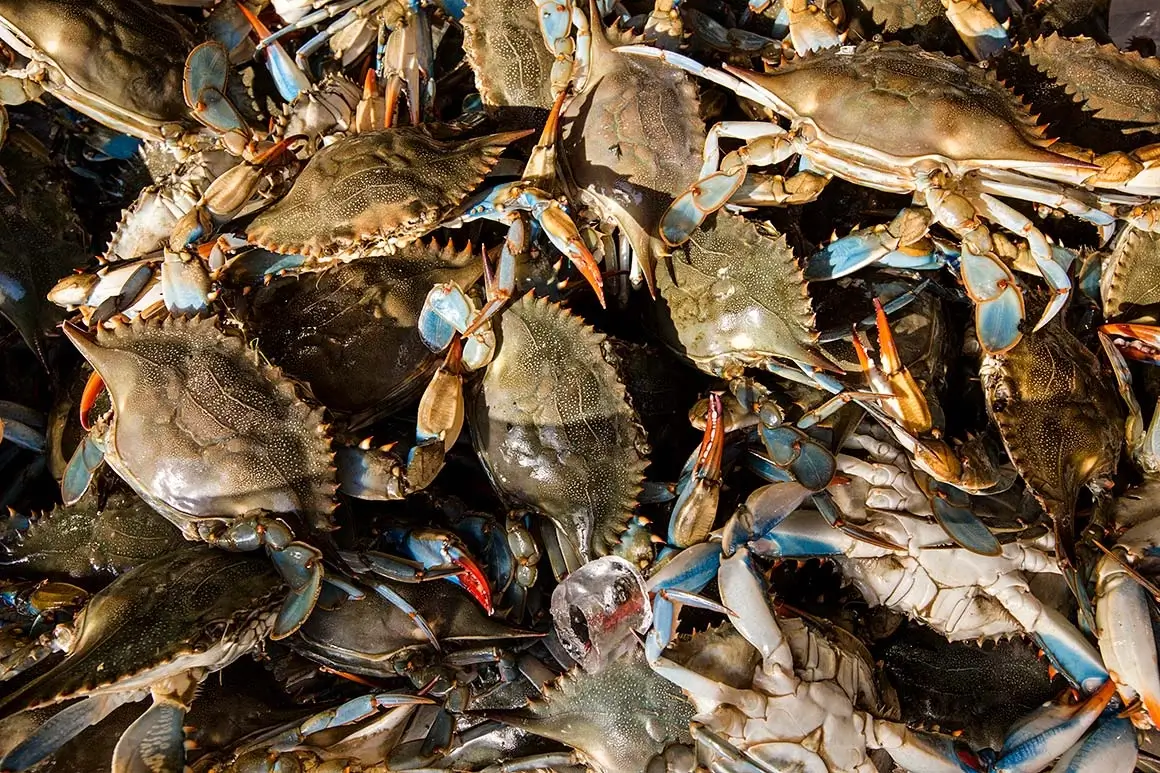
Image: eenews.net
17. Blue Crabs and Ecosystem Health: Environmental Indicators
Blue crabs in the Chesapeake Bay, essential to its ecosystem, indicate environmental health. As both predators and scavengers, they help maintain species balance, consuming various organisms and dead matter.
Fluctuations in their population, impacted by water quality, habitat conditions, and climate change, mirror broader ecological shifts. Their activities, such as sediment aeration, benefit underwater plant growth. However, overfishing and habitat loss pose significant threats.
Monitoring blue crab numbers is key to understanding and preserving the Bay’s ecological balance.
18. Blue Crabs’ Role in Folklore: Tales and Legends
Blue crabs have a rich presence in folklore and mythology globally, representing various themes.
In Chinese mythology, they’re linked to the moon and yin energy. A tale involves a giant crab against the hero Hou Yi, leading to its defeat by Hou Yi’s wife, Chang’e, the future moon goddess. In Hindu stories, a crab, embodying Vishnu, retrieves sacred texts from a demon. Native American lore associates crabs with the Cancer zodiac, symbolizing protection.
In Greek mythology, a crab dispatched by Hera to distract Hercules ends up as a constellation. African and Japanese mythologies also include crabs, portraying them as elements of trickery, grounding, and survival.
These legends highlight the crab’s multifaceted significance, from celestial symbols to embodiments of resilience and protection.
19. Scientific Studies on Blue Crabs: Breakthrough Research
In a groundbreaking study, scientists from the University of Maryland Center for Environmental Science have successfully sequenced the entire genome of the blue crab. This monumental achievement, completed over four years by a four-person team, offers a complete genetic “blueprint” of this species.
The comprehensive genetic data will greatly enhance understanding of blue crab biology, influencing conservation and fishery management strategies. It sheds light on key aspects like growth, reproduction, and disease resistance, potentially revolutionizing blue crab aquaculture.
The availability of this genome sequence to the scientific community marks a significant advancement in crustacean research.
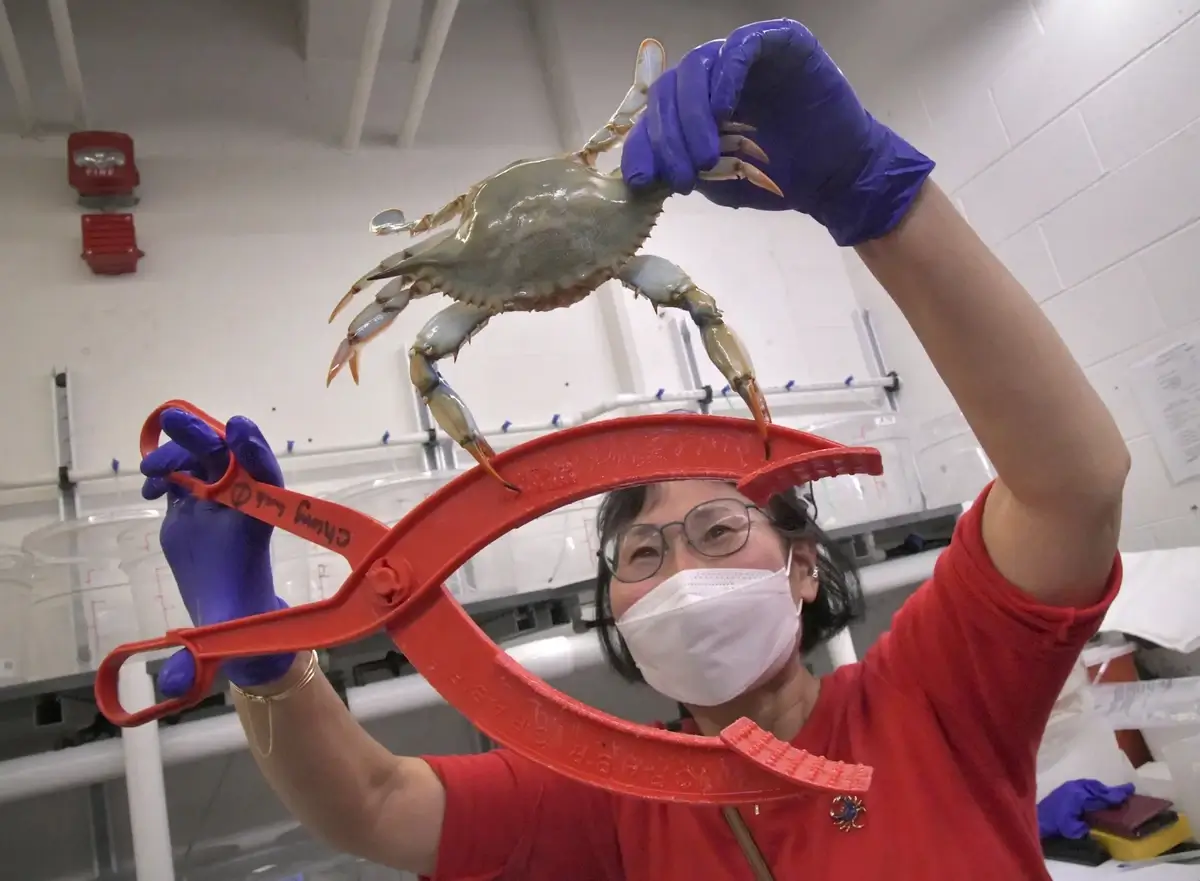
In this image, Sook Chung, a professor at the University of Maryland’s Institute of Marine and Environmental Technology, carefully lifts a blue crab out of the water using plastic tongs. This is part of her research on blue crabs. Along with Tsvetan Bachvaroff and their team at the institute, she has successfully sequenced the genome of a blue crab for the first time. Image: baltimoresun.com
20. Blue Crabs as Pets: Not Your Typical Companion
Blue crabs can be kept as unique and interesting pets. They are low-maintenance, needing minimal attention, and provide an engaging observation experience. However, they require a specific habitat that mimics their natural aquatic environment, which can be costly and time-consuming to set up and maintain.
Blue crabs need a tank of at least 10-20 gallons, with proper water conditions, temperature, and filtration. They are not social or affectionate animals, making them less suitable for those seeking interactive pets.
It’s important to consider these factors and to ensure legal compliance in your area before deciding to keep a blue crab as a pet.
FAQ
What makes blue crabs special?
Blue crabs are special due to their distinct blue coloring, particularly in males, and their significant role in the ecosystem as both predators and scavengers. They are also valued for their sweet, succulent meat, which is a culinary favorite, especially in regions like the Chesapeake Bay.
How rare is a blue crab?
Blue crabs are not considered rare. They are commonly found along the Atlantic Coast of the United States and in the Gulf of Mexico. However, their populations can fluctuate due to environmental factors and fishing pressures.
Are blue crabs smart?
While “smart” is a subjective term, blue crabs exhibit behaviors that indicate a level of adaptability and survival instincts. They are skilled at finding food and evading predators, which could be interpreted as a form of intelligence.
Why is blue crab so expensive?
Blue crab can be expensive due to several factors including high demand, particularly for their meat, and the labor-intensive process of harvesting and preparing them. Additionally, regulations to prevent overfishing can limit supply, contributing to higher prices.
Can blue crabs swim?
Yes, blue crabs can swim. They have a pair of rear legs that are shaped like paddles, which makes them strong swimmers. This ability helps them in foraging and escaping predators.
Why are they called blue crab?
They are called blue crabs due to the blue color of their shell and claws, especially noticeable in male crabs. The bright blue color is a distinguishing feature of this species.


